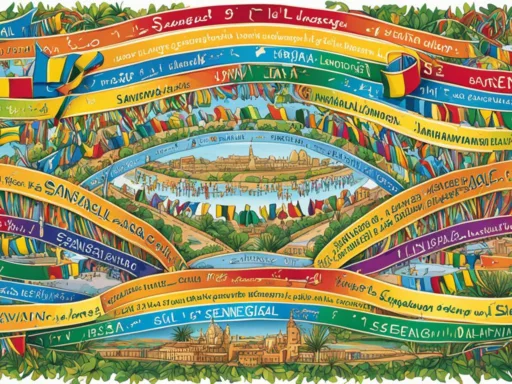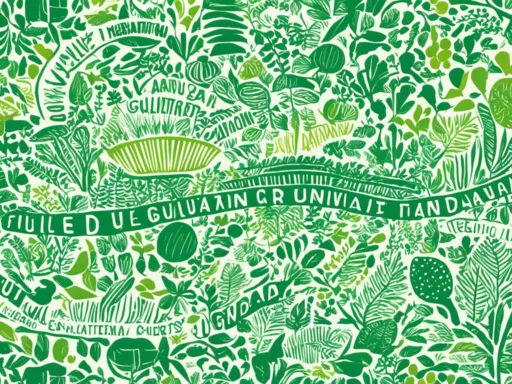Did you know that Turkmenistan, often perceived as a relatively homogenous nation, is in fact a melting pot of languages? Amidst the country’s sweeping deserts and grandiose architecture, there lies an unexpected mosaic of tongues. The languages spoken in Turkmenistan extend far beyond the belt of the traditional Turkmen dialects—one would be surprised to learn that the Turkmenistan linguistic diversity boasts a chorus of different ethnic speeches, with the Turkmen language itself being the melody that unites them all.
Primarily, Turkmen is spoken by over 3 million people, but it is not alone. This tapestry of speech weaves together the lexical strands of minority languages, such as Uzbek and Russian, across the nation’s urban and rural landscapes. These linguistic dynamics collectively paint a broader picture of Turkmenistan language statistics that does not just tell a story of numbers, but one of history, culture, and identity.
Key Takeaways
- Turkmenistan’s rich tapestry of languages reflects its vast ethnic and cultural diversity.
- Turkmen, the official language, is a part of the expansive Turkic language family.
- The nation’s language portfolio is enhanced by the presence of Russian and Uzbek among other minority languages.
- A linguistic identity transformation post-independence included a switch from the Cyrillic to the Latin alphabet.
- Turkmenistan’s urban centers serve as hubs of multilingualism, with Russian prevalent in education and commerce.
- The preservation and promotion of Turkmenistan’s linguistic diversity is crucial to maintaining its unique cultural heritage.
Turkmen: The National Language of Turkmenistan
Within the heart of Central Asia lies Turkmenistan, a nation where the Turkmen language flourishes as the bedrock of national communication. As one of the prominent Turkic languages, Turkmen stands out not only for its official status but also for the cultural legacy it carries. The nation’s language policy has played a significant role in developing and preserving the language, ensuring that Turkmenistan’s official languages maintain their historical significance and contemporary relevance.
Overview of Turkmen Language
Turkmen has a cherished place as the lingua franca in Turkmenistan, employed across governmental and educational structures. Multi-scriptural in nature, it has been transcribed historically in Latin, Cyrillic, and earlier, in Perso-Arabic scripts. The Turkmen language policy is deeply committed to fostering a sense of unity and national identity through the medium of this Turkic tongue. The current Latin script aligns with such a vision, promoting a standardized form that resonates with the Turkmen people.
The Turkic Language Family
The Turkic family of languages is noteworthy for its extensive geographical spread and linguistic characteristics, such as agglutination and vowel harmony. Turkmen is an integral member of this family, sharing similarities with other Turkic languages while also preserving its unique dialectical features. Studies and linguistic analyses often highlight the cohesiveness and shared etymological roots among the Turkic languages, contributing to a rich tapestry of dialects and vernaculars spread across Asia.
Turkmen Alphabet Evolution
The evolution of the Turkmen alphabet mirrors the country’s shifts in political and cultural landscapes. The transition from the Perso-Arabic to the Cyrillic and finally to the Latin alphabet is of historical significance, painting a picture of Turkmenistan’s journey through the ages. Each script change marked a new chapter in the nation’s commitment to cement its identity through the medium of written language.
| Period | Alphabet Used | Notable Features |
|---|---|---|
| Pre-1920s | Perso-Arabic | Calligraphic script, used extensively in literature and official documents. |
| 1920s-1990s | Cyrillic | Introduced during Soviet influence, reflecting political changes. |
| 1990s-Present | Latin | Adopted post-independence, aligning with wider Turkic language policy aspirations. |
The steadfast progression from ancient inscriptions to modern-day text highlights the importance that Turkmenistan places on its linguistic sovereignty. The Turkmen alphabet, a symbol of cultural identity, continues to evolve, embracing changes that ensure the language’s vitality for generations to come.
Russian Influence and Presence
While Turkmen is the bedrock of Turkmenistan’s national identity, the Russian language casts a significant shadow, ingrained within the nation’s cultural fabric. Turkmenistan’s language policy acknowledges this presence, maintaining Russian as a key player in the realms of education and commerce. Now, let’s delve into the specific arenas where Russian continues to assert its influence.
Russian as a Lingua Franca
The immense heritage of the Russian language in Turkmenistan is evident through its continued role as a lingua franca, especially within the cosmopolitan circles of Ashgabat and other urban centers. Despite Turkmenistan’s language policy to promulgate Turkmen, the Russian language enjoys a place of prestige and functional necessity in fostering communication across diverse ethnic and linguistic backgrounds in the country.
Russian in Education and Business
In the sphere of education, Russian is an indispensable part of the curriculum, underscoring its significance within Turkmenistan’s academic infrastructure. Similarly, in business affairs, proficiency in Russian facilitates trade and international relations, particularly with Russian-speaking countries, signifying the intricacies of Turkmenistan language policy and the practical applications of the Russian language in Turkmenistan.
| Aspect | Role of Russian Language | Turkmenistan Language Policy Considerations |
|---|---|---|
| Education | Widely taught as a second language | Includes Russian to promote bilingual competencies |
| Business | Essential for regional and international trade | Supporting multilingualism for economic advancement |
| Mass Media | Significant content available in Russian | Allows for Russian language media under regulatory frameworks |
| Cultural Exchange | Facilitates interaction with Russian-speaking diaspora | Encourages cultural dialogues and heritage conservation |
Minority Languages in Turkmenistan
Turkmenistan exhibits a remarkable linguistic variety beyond its national language, Turkmen. This abundance in Turkmenistan linguistic diversity is in part due to its ethnic minorities, who continue to speak their native tongues. Among these, the Uzbek language in Turkmenistan stands out due to its significant number of speakers and cultural impact.
Demographics of Language Use
In the symphony of minority languages in Turkmenistan, Uzbek plays a melodious part, harmonizing with the nation’s rich cultural composition. Although minority languages are not officially integrated into educational curricula, Uzbek finds its presence in the daily lives and interactions within the Uzbek-Turkmen communities.
Uzbek Language in Turkmen Communities
The Uzbek speaking community, representing approximately 5% of the total population, is a testament to Turkmenistan’s linguistic diversity. Without formal academic backing, the Uzbek language thrives through familial transmission and neighborhood chatter, especially in provinces that boast large Uzbek populations.
Below is a table highlighting the significance of Uzbek communities in various regions of Turkmenistan:
| Region | Percentage of Uzbek Population | Notable Cultural Contributions |
|---|---|---|
| Dashoguz | 9% | Traditional Uzbek music and cuisine |
| Lebap | 7% | Uzbek folk tales and craftwork |
| Ashgabat | 4% | Uzbek language community centers |
| Balkan | 3% | Integration in local marketplaces |
Encapsulating a mix of linguistic influences, Turkmenistan’s cultural fabric is enriched by each minority language, with the Uzbek language in Turkmenistan playing a key role in maintaining the nation’s vibrant multicultural identity.
Understanding Turkmenistan’s Linguistic Landscape
Turkmenistan’s linguistic fabric is as intricate and diverse as its cultural heritage. At the heart of this tapestry is Turkmen, the official language, which resides alongside a plethora of indigenous and minority languages. With Turkmenistan language statistics indicating that ethnic Turkmens make up the largest demographic group, their language enjoys prominence across the nation. However, Turkmenistan’s rich linguistic diversity is further ornamented by several Turkmenistan indigenous languages and dialects of ethnic minorities, each adding a unique thread to the country’s cultural quilt.
The government’s language policy underscores the importance of Turkmen, while still embracing the reality of a multilingual society. This approach reflects an understanding that the broad spectrum of languages spoken within the borders of Turkmenistan—including Russian, Uzbek, and Tatar—compose an essential part of the nation’s identity. Here, we take a closer look at the languages that contribute to Turkmenistan’s linguistic identity.
- Turkmen – The lingua franca of Turkmenistan, used in official settings and education
- Russian – A language of regional trade and communication, retained from the Soviet era
- Uzbek – Spoken by the substantial Uzbek minority population
- Kazakh and Tatar – Languages of smaller ethnic groups in Turkmenistan
It is evident that each language serves a specific role within the country, whether it be for administrative governance, educational purpose, cultural exchange, or daily communication. This linguistic balance is crucial for maintaining harmony in a cosmopolitan society.
“The essence of Turkmenistan’s linguistics reflects not just communication but the coexistence of history, culture, and identity across its peoples.”
An understanding of Turkmenistan’s linguistic landscape reveals more than just statistical data; it imparts insight into the intertwined destinies of its people. Just as distinct threads are woven together to create a beautiful tapestry, so too are the languages of Turkmenistan interlaced to form the fabric of a nation.
The Role of Language in Turkmen Culture
The intertwining of language with Turkmenistan cultural heritage is profoundly visible in everyday communication, where the words carry not just meaning but also the weight of tradition and shared identity. Turkmen proverbs elegantly embody the repository of communal wisdom, expressing universal truths and the values of Turkmen society. They serve not merely as didactic sayings but as essential tools in preserving the integrity of Turkmen culture.
Language and Social Identity
In Turkmen society, language is a cornerstone of social identity, shaping perceptions and reinforcing relationships within the community. It is through language that individuals signal their belonging, interact with elders and peers, and negotiate social roles. The fabric of Turkmen social life is thus dyed with the hues of its expressive tongue, enunciating a sense of belonging that is indelibly linked to the spoken word.
Turkmen Proverbs and Sayings
Like the threads of a finely woven carpet, Turkmen proverbs and sayings are intricately stitched into the nation’s cultural narrative. These proverbs, brimming with wisdom, often encapsulate ethical guidelines and ancestral knowledge, illuminating the path for younger generations. The pithy nature of these sayings makes them memorable, ensuring their passage through time as they continue to resonate in the minds and hearts of the Turkmen people.
- “A saying is a flower, a proverb is a berry.” – Turkmen proverb highlighting the value of proverbs in their culture.
- “When two wise men come together, they are sure to benefit each other.” – Reflecting the Turkmen emphasis on collective wisdom.
- “He who has no courage has no legs.” – Demonstrating the Turkmen esteem for bravery and action.
Each saying serves as a moral compass, guiding behavior and decision-making within the cultural frame of Turkmenistan. By imparting time-tested wisdom, these proverbs foster a cohesive community, grounded in the ethical values that have been the hallmark of Turkmen society for centuries.
Languages Spoken in Turkmenistan
Embarking on a journey through the linguistic panorama of Turkmenistan unveils a rich spectrum of languages spoken. At the core lies the national language, Turkmen, a beacon of cultural identity that resonates across the arid expanses and the urban landscapes alike. Beyond the dominance of Turkmen, the nation celebrates a profound Turkmen linguistic diversity that includes Russian and a vibrant array of minority languages, each painting its own stroke on Turkmenistan’s cultural canvas.

| Language | Speakers | Regions |
|---|---|---|
| Turkmen | Over 3 million | Nationwide |
| Russian | Widespread in urban areas | Ashgabat, Turkmenbashi |
| Uzbek | Approx. 300,000 | Daşoguz, Lebap regions |
The fusion of tongues spoken in Turkmenistan not only mirrors its intricate history but also signifies the intermingling of diverse cultures within its borders. This linguistic multiplicity is more than just a characteristic of the country; it’s a testament to a society that accommodates a remarkable ethnic heterogeneity, contributing significantly to the country’s singular cultural identification.
- Turkmen – The linguistic symbol of nationhood and unity
- Russian – A legacy of the past, still present in commerce and education
- Uzbek – Maintaining its prominence in Turkmenistan’s ethnic neighborhoods
As one peels the layers of Turkmenistan’s linguistic narrative, it becomes palpable that its language scene is as dynamic and colorful as the traditional Turkmen tapestries, each thread representing a unique linguistic group, woven together in harmony to depict Turkmenistan’s unique cultural identity.
Language Policy and Education in Turkmenistan
The mission to foster national unity in Turkmenistan hinges significantly on its language policy, which emphasizes the primacy of the Turkmen language in the nation’s education system. Following Turkmenistan’s independence, a conscious effort was made by the government to establish Turkmen as the cornerstone of national identity. This initiative led to Turkmen becoming not only the official language of government communication but also a compulsory subject throughout Turkmenistan’s educational institutions.
Turkmenistan language policy has seen significant developments over the years, aiming to perfect the framework necessary for effective Turkmenistan language education. The policies enacted have a strategic focus, which includes not only the enhancement of curriculum but also teacher training programs to ensure that the Turkmen language is propagated efficiently and effectively.
| Year | Policy Initiatives | Impact on Education |
|---|---|---|
| 1991 | Introduction of Turkmen Language as the State Language | Mandatory Turkmen language classes in schools initiated |
| 1993-present | Adoption of Latin Alphabet for Turkmen Language | Cross-curricular integration of Latin Alphabet in schools |
| 2000s | Enhancement of Teacher Training Programs | Improved language instruction quality |
The reticulation between language and culture is acknowledged through policy in a way that seeks to not only preserve the Turkmen language but also to fortify it for generations to come. It’s through these practiced educational imperatives that Turkmenistan maintains its linguistic heritage and ensures that its language policy aligns with its cultural and national objectives.
Linguistic Diversity and Ethnic Groups
The tapestry of languages in Turkmenistan is intricately connected to its multifaceted ethnic makeup. With a range of ethnic groups each adding their hue to the country’s cultural fabric, the linguistic diversity in Turkmenistan serves as a vibrant backdrop for its societal narratives. Recognizing the value each language brings to the national identity, there is a dedicated approach towards safeguarding these linguistic treasures.
Impact of Ethnicity on Language
As a country with a rich array of ethnic groups, Turkmenistan’s linguistic diversity is a direct reflection of its population. Ethnic Uzbeks, Russians, Kazakhs, and others, each contribute to the linguistic blend found in the nation. This reflects the historical intersections and migrations that have shaped the region, whereby each group’s language adds depth and nuance to Turkmenistan’s social and linguistic landscape.

Preservation of Minority Languages
With globalization and the dominance of major languages, the preservation of minority languages in Turkmenistan is an ongoing concern. Efforts are made on various fronts to ensure these languages are sustained, involving cultural programs, educational initiatives, and legal frameworks that recognize and protect the linguistic rights of ethnic minorities. The aim is to not only maintain linguistic diversity but also to honor the unique heritage each language carries.
| Language | Ethnic Group | Estimated Speakers | Preservation Initiatives |
|---|---|---|---|
| Turkmen | Turkmen | Over 3 million | Official language status, education in Turkmen, governmental support |
| Uzbek | Uzbek | Approx. 300,000 | Cultural events, publications in Uzbek, informal educational settings |
| Russian | Russians and various ethnic groups | Widespread in urban centers | Business and secondary education, bilingual service offerings |
| Kazakh | Kazakh | Tens of thousands | Media resources, intercultural exchanges |
As Turkmenistan navigates its future, the delicate balance between fostering a unified national language and cherishing the linguistic contribution of its varied **Turkmenistan ethnic groups** will remain pivotal. The **preservation of minority languages** is not only a cultural imperative but also a testament to the nation’s respect for its rich and diverse history, ensuring **Turkmenistan linguistic diversity** remains vibrant for generations to come.
The Interaction between Turkmen and Other Turkic Languages
Reflecting on Turkmenistan’s rich tapestry of languages, it’s evident that the Turkmen language shares a deep-rooted connection with other Turkic languages in the region, particularly Turkish and Azerbaijani. These symbiotic relationships underscore the vibrant Turkmenistan linguistic diversity and shed light on a profound cultural and historical affinity. The cross-linguistic ties not only demonstrate a shared ancestry but also influence modern communication and language development.
Turkmen and Turkish
The Turkmen and Turkish languages, like close cousins, share a multitude of similarities, their ties going back centuries. Although geographically apart, speakers often draw parallels in their linguistic expressions, highlighting the bond inherent in the Turkic language family. A Turkmen and Turkish comparison reveals matching vocabulary, grammatical structures, and phonological features that point to a lineage that travelers and linguists alike find fascinating.
Turkmen and Azerbaijani
Another neighbor in the Turkic language family is Azerbaijani, which bears remarkable similarities to Turkmen. The Turkmen and Azerbaijani similarities extend beyond mere semantics; they embody a mutual intelligibility that facilitates cultural and communicative exchanges between the two language speakers. Both tongues stem from a common linguistic heritage, making them distinct yet comfortably familiar to one another’s speakers.
| Feature | Turkmen | Turkish | Azerbaijani |
|---|---|---|---|
| Vowel Harmony | Present | Present | Present |
| Agglutinative Structure | Yes | Yes | Yes |
| Use of Suffixes | Extensive | Extensive | Extensive |
| Common Vocabulary | Moderate | High | High |
| Script Used | Latin | Latin | Latin, Cyrillic |
Understanding the inherent connections between Turkmen and its Turkic counterparts enriches one’s perspective of Central Asia’s linguistic landscape. The interplay of languages within this family not only affirms the Turkmenistan linguistic diversity but also emphasizes the cultural and communicative bonds shared across borders.
Challenges Faced by Minority Language Speakers
In the cultural tapestry of Turkmenistan, minority language speakers often find themselves wrestling with unique difficulties. The commitment to preserving the Turkmen language, which is the cornerstone of national policy, means that minority language rights in Turkmenistan can sometimes be overshadowed. Ensuring that these languages thrive amid Turkmenistan language challenges is paramount to maintaining the nation’s diverse heritage.

A quintessential aspect of these efforts lies in education. However, there is a noticeable lack of teaching and learning materials for minority languages, presenting a clear hurdle. The scarcity of resources is more than an inconvenience—it’s a barrier that inhibits the intergenerational transmission of these languages and restricts their use to domestic or communal contexts.
Wider society rarely accommodates these linguistic groups, leading to an inevitable decline in day-to-day use and relevance outside of their communities.
Additionally, the global influence of more dominant languages has the potential to diminish the practical value of smaller ethnic languages within Turkmenistan. This push and pull between global and local languages has profound implications for cultural identity and community cohesion.
- Limited educational opportunities for minority languages
- Underrepresentation in media and governmental discourse
- Risks of linguistic assimilation and erosion of minority languages
- Need for robust policy support for the preservation and promotion of minority languages
As the need for action is recognized, advocates for minority languages are voicing their concerns and calling for policies that not only protect but also nurture the linguistic diversity of Turkmenistan. Their ultimate objective is to strike a balance that respects the status of Turkmen while also upholding the value and presence of minority languages within the fabric of the nation.
Conclusion
The exploration of Turkmenistan’s rich linguistic landscape reveals language as a fundamental element of the nation’s cultural heritage, emblematic of its historical depth and contemporary vibrancy. The articulate tapestry of Turkmen, Russian, and an ensemble of minority languages—notably Uzbek—provides an insightful window into the country’s identity, characterizing the intersection of the past with the present, and laying the foundation for the future.
Importance of Language for Cultural Heritage
Language in Turkmenistan is more than a tool for communication; it is an invaluable cultural asset that encapsulates the soul of the nation. From the intricacy of traditional proverbs to the administrative use of Turkmen in government affairs, every linguistic nuance contributes to safeguarding Turkmenistan’s multifaceted cultural heritage. The country’s narrative, etched in every word and expression, remains deeply rooted in the collective memory and shared experiences of its people.
The Future of Languages in Turkmenistan
Looking toward the horizon, the languages spoken in Turkmenistan face a dynamic future where strategic emphasis on language policy and continued advocacy for linguistic inclusivity will be paramount. Preserving the wealth of Turkmenistan’s linguistic heritage hinges on amplifying these voices, upholding the legacy of Turkmen, and giving due reverence to minority languages. As the nation progresses, the empowerment of its diverse linguistic fabric stands as a testament to its cultural unity, individuality, and resilience. The commitment to fostering an environment where all languages can thrive will undoubtedly shape the languages spoken in Turkistan’s future, weaving yet another rich layer into the nation’s ongoing story.






